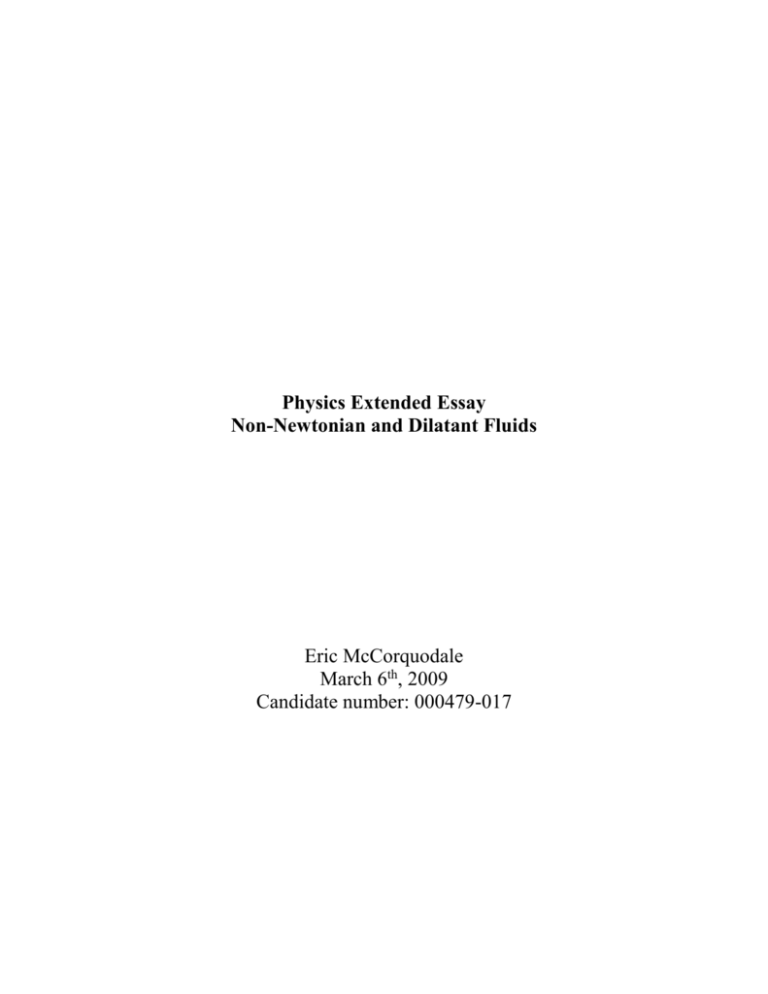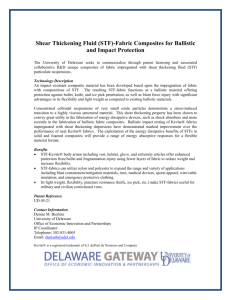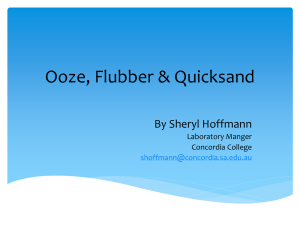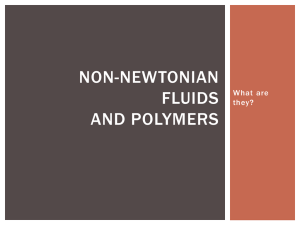Physics Extended Essay
advertisement

Physics Extended Essay Non-Newtonian and Dilatant Fluids Eric McCorquodale March 6th, 2009 Candidate number: 000479-017 Eric McCorquodale 000479-017 2 Non-Newtonian Fluids Contents Page Research Question 3 Abstract 3 Introduction 4 Body 5 Lab Investigation 14 Lab Journal 18 Conclusion 20 Bibliography 21 Eric McCorquodale 000479-017 3 Research Question What gives non-Newtonian, or more specifically shear thickening and thinning fluids their unique properties? What are non-Newtonian fluids used for, and what other practical purposes could they have? Abstract This essay looks at the possible applications, and current uses for non-Newtonian fluids. It also explains the current theories for how nonNewtonian fluids work. Shear thickening fluids should be able to achieve a maximum possible force through a ratio of particles to lubricant. My investigation into this matter can only go so far though. I have looked at several non-Newtonian fluids, as well as their applications, such as the use of silica nanoparticles in traction control, advancement in body armour, and protective gear. In the lab portion of the essay, I showed that as the concentration of the particles that make shear thickening fluid increases, the force it is able to apply to an object also increases. Furthermore, we should be able to find a concentration at which the shear thickening fluid will be strongest. This strong concentration should be used to treat Kevlar, and could be used in traction control systems for superior performance. Eric McCorquodale 000479-017 4 Introduction I first came across non-Newtonian fluids when watching an episode of the television series Numb3rs. In the show, several people run across what appears to be a pool of liquid. Initially I thought that I could not make such a liquid, but after further investigation, I found out that these liquids are very common and fairly easy to make. Several companies use non-Newtonian fluids in their protective gear, and traction control systems as well as many other products. In this essay, you will see how non-Newtonian fluids are used, and I will attempt to explain, and understand how they work. A lab investigation will also be involved, as I try to show that the amount of particles in a shear thickening fluid correlates with the force it is able to apply on an object. Eric McCorquodale 000479-017 Body A fluid is called non-Newtonian if it does not conform to Newton’s equation describing viscosity, F/A=v/Z. A Newtonian fluid will conform to this equation, and viscosity will be a constant for that liquid when a constant temperature is achieved. “F” stands for the force applied to the liquid, and “A” stands for the area over which said force is applied. On the other side of the equation, “” represents the viscosity of the liquid, “v” represents the velocity of the planes, and “Z” is the distance between the planes. Viscous forces in a fluid. (Earle, 1983) A non-Newtonian fluid can be put into the equation, =k(dv/dz)n , where , the shear stress of a fluid, is the constant of proportionality multiplied by the shear rate, dv/dz. For a shear thickening fluid, n will be smaller than one, and for a shear thinning fluid, n will be greater than one. (Earle, 1983) Shear stress/shear rate relationships in liquids (Earle, 1983) 5 Eric McCorquodale 000479-017 6 Here are some important definitions for future reference. Non-Newtonian Fluid: A non-Newtonian fluid’s viscosity does not fall under a constant value. This is the opposite of a Newtonian fluid, where there is a linear relationship between shear stress and the rate of strain applied by the fluid. These fluids can change their viscosity depending on time, shear stress, or based on a variety of other factors. Some common examples are quicksand, ketchup, and Silly Putty. A dilatant fluid is an example of a non-Newtonian fluid. A dilatant, or Shear Thickening Fluid (STF), is a fluid whose viscosity increases non-linearly as the rate of shear increases. This falls under the definition of a non-Newtonian fluid. Shear: The shear is a force applied tangentially to the face of a solid object. Shear will be applied to any solid surface (boundary or object) that a liquid comes into contact with. Shear Stress: For Newtonian fluids, this is proportional to the shear rate. The shear strain divided by the rate of shear strain is a constant for any given liquid. The rate of shear strain is the rate of deformation for the liquid when a parallel force is applied. For non-Newtonian fluids, the constant Shear stress F/A = v /Z = (dv/dz) = This is the equation that Newton proposed for shear. Shear Rate: The rate at which shear is applied to a surface. Expressed dv/dz. The picture above shows how the Newton’s equation for shear stress relates to a liquid. 1 1 http://upload.wikimedia.org/wikipedia/commons/a/a4/Laminar_shear.png Eric McCorquodale 000479-017 7 Rheology: Rheology is the study of the flow of unusual materials, particularly nonNewtonian fluids. Rheology is the science of deformation and flow of matter. Non-Newtonian Fluids Explained There are two types of Non-Newtonian fluids, shear thickening fluids and shear thinning fluids. Shear thickening fluids are a specific type of nonNewtonian fluid whose viscosity increases as the shear stress applied increases. For all practical purposes, a dilatant fluid is a shear thickening fluid. Dilatant fluids act as a liquid when pushed at low velocity, but when a high velocity object hits the liquid, friction between the particles increases dramatically and the object is unable to move. An example of a dilatant fluid and the fluid that I will be researching is a polymer mixture of cornstarch and water commonly referred to as oobleck. (Oobleck was originally used to describe an imaginary liquid in Dr. Seuss’s book, Bartholomew and the Oobleck) There are many experts who argue that dilatant fluids are simply powder polymers that dilate and expand in volume when an uneven force acts upon it. In any case, dilatant fluids demonstrate the properties of shear thickening fluids, and, for this paper, will be considered to be a shear thickening fluid. The water and cornstarch solution that we used in our lab is a dilatant fluid. As a dilatant fluid, the force keeping it together comes from the friction between particles when a force is applied to it. When a force is applied to a dilatant fluid, the cornstarch particles hit each other, and the force holding it together comes from the friction between the particles of cornstarch. In the water and cornstarch solution, the water acts as a lubricant, so that the cornstarch can move relatively easily when no uneven force is applied. The water allows the normally solid cornstarch to act as a liquid in this case. When an uneven force is applied, however, the lubricating water particles between the cornstarch particles move aside, and the cornstarch acts as a solid once again. The name dilatant is given to this and other similar fluids, because of its dilation, or expansion. In other words, these fluids expand when a force is applied, or if you attempt to Eric McCorquodale 000479-017 8 splash it. This expansion is due to the pores between the particles getting bigger. Since it is being both compressed and expanded, there is no net deformation of the liquid. When the pores between particles are expanded, the cornstarch particles come into contact and form a lattice-like structure, and act as a solid. Applications Many companies use non-Newtonian fluids with their personal protection and padding products. Among the most prominent of these companies are Zoombang, d3o, and Dow Corning. The basic idea behind all of their products is that under normal conditions the padding will remain flexible, and comfortable, but upon impact, the padding will stiffen to provide protection from any blow. The particles form a lattice-like structure that will remain together as long as the impact remains. Zoombang protective gear uses an undefined shear-thickening polymer. They say this polymer will “stiffen in proportion to the energy applied.” Zoombang calls their polymer a “Viscoelastic” polymer because of its elastic and flowing properties. (MacKinley, 2009) This polymer will stiffen when a force, or some other shock, but remain as a liquid in normal conditions. Zoombang claims to have hundreds of professional athletes who use their products. As with all protective gear that uses shear thickening technology, Zoombang provides protection along with flexibility and the freedom to move. (zoombang.com) D3o describes the active particles in their product only, “intelligent molecules”. Upon further investigation, the only thing I could find out about their technology was that it used silica nanoparticles. D3o, which is based in Hove, East Sussex, has many products for athletes such as goalkeeper gloves, ski helmets and boots, that all use shear thickening fluids to protect the wearer from impact. D3o’s managing director said, “Sometimes it’s hard to convince people what a truly amazing innovation this is until you demonstrate it. I was wearing a prototype shirt incorporating d3o, and at one point I stood up and slammed my elbow onto the table as hard as I could, sending coffee cups flying. Once they saw me doing that - without flinching - they understood what I was saying.”2 These products truly are revolutionary, and without a doubt very interesting. (d3o.com; Palmer, 2004) 2 2004, http://www.azom.com/details.asp?ArticleID=2555 Eric McCorquodale 000479-017 9 Dow Corning claims that their Active Protection System, or APS, is superior to other shear thickening fluid based padding and protective gear. They use the same basic principles seeing as Dow Corning’s padding will become rigid if a high velocity force hits it, but they use fabric so that the skin underneath it can breathe. The fabric is made of cross-linking bonds of a dilatant silicone polymer. They claim the fabric will absorb and dissipate shock through the material. They do highlight a limitation for other shear thickening fluid protective gear. Allowing the skin underneath to breathe could be a major marketing tool for products aimed at athletes, and industrial workers, as well as soldiers and policemen. Dow Corning also states that their technology has potential to be used for body armour, but do not actually manufacture any such products. The only unique idea that Dow Corning had was that their technology could be put to use in architectural design. The same can go for the other similar products. (Dow Corning APS) (Dow Corning APS) Body armour is possibly the most interesting application for shear thickening fluids. Body armour that is completely flexible, but turns extremely hard when struck by a bullet or shrapnel sounds like it is straight out of a science fiction movie. No movie is needed to make this possible though, only shear thickening fluids. The body armour that is currently used Eric McCorquodale 000479-017 10 usually consists of several layers of Kevlar, and heavy ceramic plates. Rheologists are working on ways to use shear thickening fluids to provide the same service as body armour without the weight and inflexibility that our current body armour has. Obviously the padding and protective gear mentioned above wouldn’t be suitable for combative purposes. Those products are only meant to protect the body from impacts of relatively small force, like being hit in hockey, or American football. We should look at some other applications of shear thickening fluids that could help protect the body from high velocity impacts, such as bullets. The U.S. Army Research Labs are working with the University of Delaware to produce body armour. Their armour consists of only a couple of layers of Kevlar fabric that has been treated with a shear thickening fluid. The fabric is soaked in shear thickening fluid, then pressure is applied, and the fabric is put through a wringer. This way, only about ten layers of Kevlar are needed to protect the wearer from the force of a stab, rather than about forty layers in regular police body armour. The problem that arises with an impact from a bullet is that bullets are dense, and the force of the blow is very concentrated over a small area. The image below3 shows that two layers of Kevlar that have been treated with shear thickening fluid can withstand shots from multiple arrows. The untreated Kevlar, even with double the layers, could not withstand the arrows, and all four arrows were able to puncture the fabric. Of course it would not be wise to send soldiers into battle with two layers of treated Kevlar. Bullets can travel over ten times the speed of the arrow used in these tests. 3 http://www.ccm.udel.edu/STF/image_gallery/testing4.jpg Eric McCorquodale 000479-017 11 This is a picture of a container of polyethylene glycol with 400 nanometer silica nanoparticles. This was one shear thickening fluid used by the U.S. Army Research Labs to treat the Kevlar. This shear thickening fluid is also suspended in water but will not clump up like the cornstarch because the particles repel each other slightly. Upon impact the particles will hit each other and harden. (Wilson) (Wilson) This is treated Kevlar after the impact from a bullet. For slow moving impacts, such as a slow, forceful stab, the treated Kevlar will sustain a small amount less damage than untreated Kevlar, possibly due to the liquid holding the fabric together. Eric McCorquodale 000479-017 12 Traction control systems often use shear thickening fluids in their viscous coupling units. The fluid used is quite often a silica polymer, much like the polymers used in protective gear. The viscous coupling unit consists of two rotating plates. If the two plates are rotating at the same speed, the silicone will act as a liquid. Very little power will be transferred to the secondary drive wheels. However, if the two plates are rotating at different speeds, the silicone will start to solidify, and power will be transferred as needed to the secondary drive wheels. (ChemistryDaily, 2007) Shear Thinning Fluids The opposite of a dilatant fluid would be a shear thinning fluid, such as whipped cream. When no uneven forces act on the whipped cream, it is stationary, and does not flow like a liquid would. You can see it acts as a solid, because it can stand up without support instead of making a puddle as a liquid would. When a force is applied to the whipped cream, it moves and deforms like a liquid would. NASA recently did a study on shear thinning fluids, using xenon as their test liquid, because xenon is a very simple molecule to understand. (Phillips, 2008) A shear thinning fluid’s fluidity depends upon the stress being applied to it. Some common examples include but are not limited to pseudo plastics, lubricants, paint, whipped cream, and Bingham fluids. As the force and velocity applied over an area of the fluid increases, the fluid will become easier to flow through, as the viscosity will decrease. The main difference between shear thickening fluids and shear thinning fluids is that shear thickening fluids appear to change into solids upon shearing, whereas shear thinning fluids will appear to be more gaseous when shear is applied. It is not entirely clear how shear thinning fluids work. One very plausible theory says that shear thinning fluids are comprised of large molecules in a solvent of smaller molecules. At rest, the larger molecular chains will be aligned at random. Under a shear force, however, the larger chains will be forced to align with one another, reducing volume, and producing less friction against the shear. The explanation given by the NASA group is that upon shearing forces, a shear thinning fluid will become partially gaseous, and flow more easily. (Phillips, 2008) In automotive terms, it could be very useful to find effective shear thinning fluids. Shear thinning lubricants could be very useful to produce Eric McCorquodale 000479-017 13 and maintain high efficiency vehicles. Finding and investigating nonNewtonian fluids could also be useful in geology. (Balmforth, UBC) A study aboard Space Shuttle Columbia called Critical Viscosity of Xenon, or CVX2, highlighted a way in which shear thinning fluids can be studied. NASA scientists describe a fluid’s critical point as a “special combination of temperature and pressure where fluids can exist as both a liquid and a gas simultaneously. At their critical point, simple fluids are able to "shear-thin" (a verb) just like whipped cream does.” 4 This means that at certain temperatures and pressures, any fluid can act as a shear thinning fluid. I also liked Phillips’s explanation of the shear thinning process. Phillips wrote, “When part of the foam is forced to slide or "shear" past the rest of the foam, the foam "thins." It becomes less like honey and more like water, allowing it to flow easily until the shearing stops.” (Phillips, 2008) (Phillips, 2008) The critical point for xenon is shown here. This critical point can theoretically be achieved for any liquid. Tony Phillips, 2008, http://science.nasa.gov/headlines/y2008/25apr_cvx2.htm? 4 Eric McCorquodale 000479-017 14 Shear Thickening Fluids Lab Investigation Purpose: To find the force holding a shear thickening fluid together with different ratios of the active particles in the polymer in comparison to a Newtonian fluid. Hypothesis: The water acts as a lubricant for the particles of cornstarch. As more cornstarch particles are added to the solution, the force holding the fluid together should increase. =k(dv/dz)n , n>1, This equation is important when calculating shear, but we are only comparing forces, so it will not be needed. In this experiment, the shear will be acting on the surface of the weight. The force of the liquid’s shearing on the weight will be found. Since the surface area of the weight, and the depth are constant, the force holding the weight back in these conditions should be equal to the force of subtracted from the net force of the weights. Materials: Pasco Data Studio interface Pasco Photogate sensor, and smart pulley system Computer with Data Studio application Several containers to hold liquid (Ice cream containers, etc.) Beakers (400mL, 500mL, 1L) Water 3 kg of cornstarch Spoon Meter sticks A 400g electronic scale Procedure: Equipment setup 1. A retort stand is placed on a table. 2. A horizontal clamp is attached near the top of the stand. 3. On the clamp, put the photogate along with the smart pulley. 4. The photogate is attached to the Data Studio interface, which is connected to the power outlet and a computer with the Data Studio application installed. Eric McCorquodale 000479-017 15 5. Two weights are tied to a string, which has been strung through the smart pulley apparatus. Fluid setup 1. 500mL of water is measured out into a 4L ice cream container. 2. 500g of cornstarch is measured out, and mixed into the water. 3. The container is placed under the retort stand so the smaller weight can drop into the liquid, but the heavier weight will fall outside of the container. Trials 1. The 50g weight is suspended so that the 20g weight is resting just below the surface of the liquid, and just above the bottom of the container. 2. The “play” button is pressed in the Data Studio application to start recording the velocity and acceleration of the weights. 3. The 50g weight that was being suspended is now released, and the weights will move. 4. After the weights have stopped moving, the data being recorded is stopped. 5. This is repeated four more times for every liquid. Recalibration 1. After every five successful trials, cornstarch is added to the solution to change the ratio of cornstarch to water. Variables: Independent: Ratio of cornstarch to water Dependent: Fl, force produced by the shear thickening fluid Control: Depth of liquid Force applied Area of force Surface area of object All of these will remain constant in order to compare the force of the STF to the force produced by a Newtonian fluid. The mass is suspended just above the bottom of the container to ensure that no suction occurs, where the weight could get stuck to the bottom of the container, and affect the experimental values. Eric McCorquodale 000479-017 Data: Mass 1=20g Mass 2=50g Height of Mass 1=21 ± .1mm Diameter of Mass 1=14 ± .1mm Distance between table and pulley = 54 ± .2 cm Distance between 50g weight and table = 23 ± .2 cm Length of string = 84 ± .2cm Net force upward on mass 1= 0.2943N Surface area for shear on mass 1= .92 ± .01m Average acceleration of mass 1 out of a Newtonian fluid = 3.56 m/s/s Experimental net force of weights = .1068 N Fl=.1068N - .03 x a Where a is acceleration of the weight This is an example of what the velocities of the trials looked like. These trials were for the solution of 1.4:1 ratio of cornstarch to water. QuickTime™ and a TIFF (Uncompressed) decompressor are needed to see this picture. Sample calculation: F=m x a F= .03kg x .44 ms-2 =.013 N, Fl=.1068N-F Fl= .092 N 16 Eric McCorquodale 000479-017 Ratio 5:5 6:5 6.5:5 7:5 Unknown 17 Force (N) 0 0.042 0.064 0.098 0.092 The Unknown ration is just slightly under 1.4:1. As you can see there was a big change in force when adding only 50g of cornstarch, so the difference between the 7:5 ratio and the unknown ratio was very small. As the amount of cornstarch increases, the force applied to an object moving through the liquid also increases. This could suggest that the theory of the cornstarch particles forming a lattice structure is correct, but it does not prove it. Eric McCorquodale 000479-017 18 Lab Journal One very interesting serendipitous event occurred while in the process of preparing this lab. The proper ratio of cornstarch to water had already been achieved to form a non-Newtonian fluid. A thin layer of cornstarch was spread evenly across the surface of the fluid. When the layer of cornstarch was hit with a meter stick it would not move, spread, or split, but apply the force of the blow across the entire fluid. When the meter stick pushed the layer of cornstarch, however, the layer would sink to the bottom of the fluid. This suggests that if a layer of material were placed across such a non-Newtonian fluid, it would help disperse the blow more evenly. My thoughts went directly to Kevlar. If a thin piece of Kevlar were reinforced by pockets of shear thickening fluid then the force and kinetic energy of a bullet would be dissipated through the armour. Once we got to a ratio of cornstarch to water of about 1.4:1, it became very difficult even to stir the solution slowly. A lot of the cornstarch had clumped up, and it was obvious that we couldn’t test solutions over this ratio. All that was left in the bucket looked to be almost completely cornstarch, although it was obviously a bit wet. The practical applications of a cornstarch and water polymer are very limited. For one thing, the consistency must remain constant, so any addition of water or contact with water for that matter would ruin the consistency. Also, the cornstarch particles sink to the bottom of the water after a while if it is not stirred properly. This would affect the consistency, making it dry and starchy in some places, while leaving the solution watery in others. One way to get around this could be to seal the solution in small, airtight packets. This would prevent the water from evaporating, but will not prevent the particles of cornstarch from settling, and forming clumps so the force of a blow will not be distributed evenly. For this reason, a silica polymer would be better for use in armour and padding rather than a cornstarch based product. Eric McCorquodale 000479-017 19 Lab Applications My idea for body armour using a cornstarch based shear thickening fluid goes as follows. The cornstarch and water solution would be sealed in small airtight packages, lined with Kevlar. These packages would be hexagonal and triangular in shape to provide an interlocking pattern without holes in between each packet. The packets would be held in place by a thin layer of rubber, which would help to dissipate the shock of a bullet. Obviously rheologists, and other experts have been able to come up with a much better solution to the body armour issue, but my idea could still work. Coating the liquid with Kevlar should help distribute the impact of a bullet more evenly. It would be much better to use a silica polymer, rather than a cornstarch solution though. Not only would it be stronger than the cornstarch, but also it would not clump up and lose consistency. If the force that a shear thickening fluid is able to apply on an object correlates with the concentration of the active particles, then we should be able to strengthen the force infinitely. This is not true. There should be a point where a shear thickening fluid is strongest. I say this because at a certain point (in our case a 1.4:1 ratio), the fluid became less like a fluid, and more like wet cornstarch. This makes sense under the theoretical explanation for a shear thickening fluid used. There should be a point where the solution keeps its fluidity, and is able to stiffen upon impact from a maximum force. Eric McCorquodale 000479-017 20 Conclusion I have looked at several non-Newtonian fluids, as well as their applications, such as the use of silica nanoparticles in traction control, advancement in body armour, and protective gear. In the lab portion of the essay, I showed that as the concentration of the particles that make shear thickening fluid increases, the force it is able to apply to an object also increases. Furthermore, we should be able to find a concentration at which the shear thickening fluid will be strongest. This strong concentration should be used to treat Kevlar, and could be used in traction control systems for superior performance. These interesting fluids obviously have many possible applications that have not yet been realized. Limitations An advanced laboratory would have been nice to do this essay. Unfortunately I am not currently in possession of an advanced laboratory. It is very difficult to make an accurate prediction of what gives fluids such as non-Newtonian fluids their properties. Although there are some more plausible solutions, it is impossible to tell if theories are correct with the current knowledge and resources that I have. Also, with better resources, it may be possible for me to test other shear thickening fluids, such as silica nanoparticles. It would be interesting to see how other shear thickening fluids stand up to the cornstarch solution. Without the ability to test other fluids, it is not possible to test my theory that shear thickening fluids have a maximum strength. Eric McCorquodale 000479-017 Sources Balmforth, N. Non-Newtonian Fluid Dynamics and Applications, UBC website, http://www.math.ubc.ca/~njb/Research/non-newtonian.htm Chemistry Daily, 2007, Dilatant, http://www.chemistrydaily.com/chemistry/Dilatant Dow Corning APS, http://www.activeprotectionsystem.com/index2.html Earle, R. L. 1983, Unit Opertions in Food Processing, http://www.nzifst.org.nz/unitoperations/flfltheory3.htm MacKinley, G. 2009, Non-Newtonian Fluid Dynamics Research Group at MIT, http://web.mit.edu/nnf/ Palmer, R., 2004, d3o Create Intelligent Material for Use in Protective Clothing, http://www.azom.com/details.asp?ArticleID=2555 Phillips, T. 2008, The Physics of Whipped Cream, http://science.nasa.gov/headlines/y2008/25apr_cvx2.htm? Wilson, T., Liquid Body Armor: Shear Thickening Fluids, http://science.howstuffworks.com/liquid-body-armor1.htm Other Web Sources Used http://upload.wikimedia.org/wikipedia/commons/a/a4/Laminar_shear.png http://www.d3o.com/ http://www.zoombang.com/ http://numb3rs.wolfram.com/416/ http://www.ccm.udel.edu/STF/image_gallery/testing4.jpg 21






